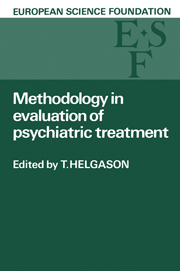 Methodology in Evaluation of Psychiatric Treatment
Methodology in Evaluation of Psychiatric Treatment from I - METHODS OF CLASSIFICATION
Introduction
This paper is chiefly concerned with the advantages of introducing a degree of standardization into the processes of psychiatric diagnosis. The term ‘diagnosis’ refers both to a particular category within a nosological system and to the means whereby a decision is reached that a particular category is the one most appropriate for describing the patient's condition. I shall be concerned mainly with the second of these usages, i.e, with methods of standardizing the processes whereby a clinician collects information from and about patients and then classifies it, using the categories of some established system such as the International Classification of Diseases (WHO, 1978). However, any attempt at operationalization reveals hitherto unsuspected gaps where new categories may be needed, overlaps between categories previously thought to be discrete and, above all, a lack of clarity and precision in the definitions used by clinicians in daily practice. Constructing an operational system that simulates the processes of diagnosis, whatever the nosological classification, therefore requires its designers to use their own clinical judgement whenever there is any doubt. From a clinical point of view, the ‘standard’ system will have many of the characteristics, both good and bad, of the clinical system it is simulating. There is no way out of this; all that can be claimed is that the designers’ judgements are made within the spirit of a given school, and that they are specific, public and amenable to test by others. This claim, however, is a large and important one and lies at the heart of all scientific enquiry.
There is no possibility at the moment of standardizing all the elements in any diagnostic system, nOJ even of altogether standardizing anyone of them. There will always be unforeseen contingencies, complex modifying circumstances, and large gaps in knowledge, particularly in the absence of highly discriminating laboratory tests. In the face of uncertainty, the clinician's judgement, fallible though it is, must be paramount. The techniques I shall discuss are of great value to research workers, but any tendency to use them as substitutes for clinical practice (except through their increasing role in education) is greatly to be deplored.
To save this book to your Kindle, first ensure [email protected] is added to your Approved Personal Document E-mail List under your Personal Document Settings on the Manage Your Content and Devices page of your Amazon account. Then enter the ‘name’ part of your Kindle email address below. Find out more about saving to your Kindle.
Note you can select to save to either the @free.kindle.com or @kindle.com variations. ‘@free.kindle.com’ emails are free but can only be saved to your device when it is connected to wi-fi. ‘@kindle.com’ emails can be delivered even when you are not connected to wi-fi, but note that service fees apply.
Find out more about the Kindle Personal Document Service.
To save content items to your account, please confirm that you agree to abide by our usage policies. If this is the first time you use this feature, you will be asked to authorise Cambridge Core to connect with your account. Find out more about saving content to Dropbox.
To save content items to your account, please confirm that you agree to abide by our usage policies. If this is the first time you use this feature, you will be asked to authorise Cambridge Core to connect with your account. Find out more about saving content to Google Drive.